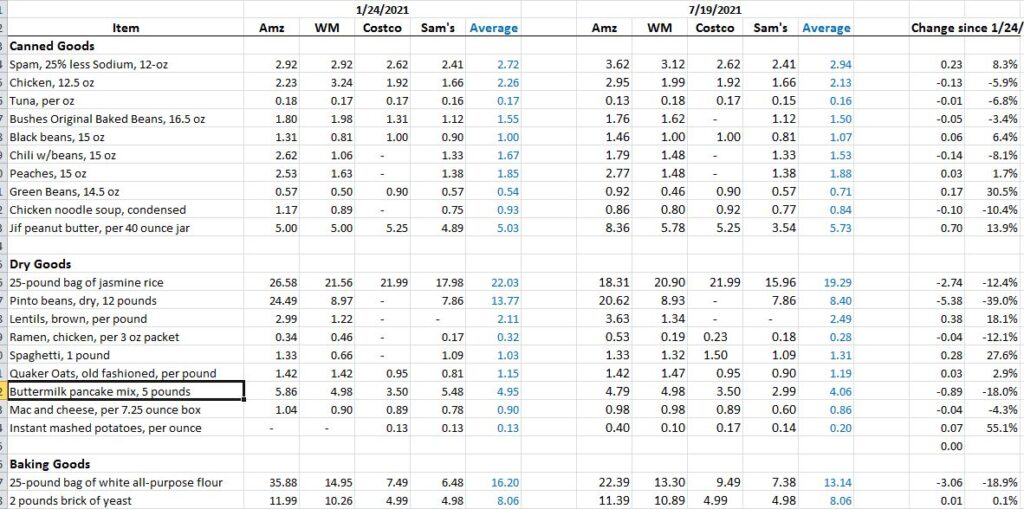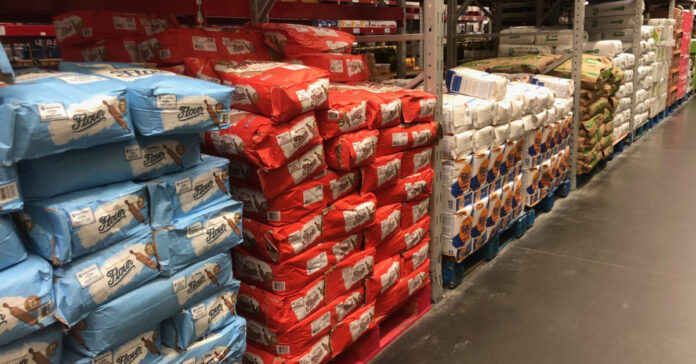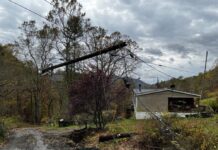Despite the hue and cry about food inflation, preppers looking to stock their pantry with staple items that have a good shelf life can do so without spending more than they would have in January. A summary of our results comparing the prices today with those we recorded 22 weeks ago on January 24 follows:

Clearly, Amazon is an outlier here, with prices well above the others. If we remove Amazon from the equation, we get the following:

Note: full details on our methodology are at the bottom of this article.
Why the Decrease?
While inflation is heading upwards, I believe these prices fell for two reasons: First, January was the peak of COVID-19 infections and demand was high while supply chain problems were rampant, causing Amazon, which relies heavily on third party sellers, to have higher prices. Second, the price increase we’ve seen in meat and fresh foods have not yet trickled down to most of the shelf-stable canned goods, baking ingredients, and dry goods sold by our select four retailers.
I don’t know whether it is the manufacturers or the large retailers who are holding a lid on pricing, but when it starts to impact profits, expect prices to jump. Smart preppers will buy all they can before that time comes.
Ranking the Best Places to Stock Your Prepper Pantry
I rank Sam’s Club as the best place for preppers to shop for items on our prepper pantry list, which includes canned foods, dry goods, baking goods and household supplies. Based on our four price and inventory checks over the past 22 weeks, Samsclub.com has the lowest overall prices and a high percentage of in-stock items, missing only lentils.
I rank Costco.com second and had the next lowest prices, but seven items on our list were out of stock, including three canned goods.
Walmart.com is number three on our list. While every single item was available at Walmart, shopping there would cost $27.23, or 44 percent, more than shopping at Sam’s Club. However, shopping at Walmart in person will reduce this disparity somewhat.
I ranked Amazon.com dead last because it has the worst pricing of the four websites we checked. Filling our shopping list there costs almost twice as much as doing so at samsclub.com ($120.18 vs $62.51). As we have stated before, their prices on heavy items like flour and rice hurt them in this report. Amazon has a broad selection, so we recommend Amazon when you cannot find what you are looking for somewhere else.
Here are some more detailed results from each online retailer:
Amazon
While Amazon’s prices have dropped 16.4 percent over the period of our study, they remain a very expensive choice. They also have the least predictable pricing and can see prices swing overnight or multiple times in a period of a week. When I leave items in my Amazon.com shopping cart, it is not unusual to find a note saying the price has changed when I next log in. I have learned to watch items closely and buy when the prices are lowest as the swings can be quite significant.
Even as the overall cost of the shopping basket at Amazon dropped, there were also increases.
- Spam jumped from $2.92 to $3.62, an increase of 70 cents or 24 percent.
- A 40-ounce jar of Jif creamy peanut butter shot from $5 to $8.36, an increase of 67 percent.
- A can of chili with beans, on the other hand, dropped from $2.62 to $1.79, a decrease of 83 cents or 32 percent.
- This report saw their best price on a 25-pound bag of jasmine rice ever, $18.31, a 31 percent decrease.
Walmart
Our review of the products from Pete’s list of survival staples on Walmart.com showed both price increases and price decreases. Because most of the prices increases were only a few cents, the result was actually a small decrease in the cost of the shopping basket at Walmart. Shoppers who buy at Walmart.com saw savings of 1.2 percent since January 24.
Here are a few notable price swings:
- Spam increased from $2.92 per can to $3.12, an increase of 7 percent.
- A 12.5 ounce can of chicken dropped from $3.24 to $1.92 a 30 percent decrease.
- A two-pound brick of yeast increase from $10.26 to $10.89, a 6.1 percent uptick.
When shopping at Walmart.com you will only save money if you are not picky about brand and are willing to buy some larger sizes to cut your per-can or per-ounce cost. Like Costco’s Kirkland brand, some of the best buys at Walmart are only available if you buy their Great Value brand.
We should note that prices of many items, from black beans to mac & cheese, can be significantly less if you pick them up at Walmart rather than shop online. If you expect an emergency, my advice would be to place an order on Costco.com and/or Samsclub.com for two-day delivery and then run to Walmart to fill your shopping cart in person.
Costco
Note that the reason our cost for Costco is so low on the chart above is because they did not have everything in stock (see below).
Most of the staple items on our list at Costco were unchanged in the 22 weeks since we started this inflation survey. However, there were a few notable exceptions, leading me to believe that when Costco hikes a price, it can be substantial. For example:
- Flour was up $2 for a 25 pound (8 cents per pound) bag since our May report. That’s a 27 percent increase and the most obvious impact of inflation.
- The Kirkland 33-gallon trash bags were up 2 cents per bag since our January report. That is an increase of 10.5 percent. They warned us that plastic items would see price increases, so this is not unexpected.
- Instant mashed potatoes also saw a significant increase, up four cents per ounce since January. That’s about 30 percent.
Once again, Costco’s website had some notable products that were out of stock, including Scott’s toilet tissue, pinto beans, and Bush’s baked beans. There were seven items out of stock this time, five out of stock in May, eight out of stock in February and ten out of stock in January, which was at the height of the COVID-19 pandemic. Note, however, that items like dried lentils and canned peaches have never been in stock so we must assume they intentionally do not stock these products.
If you look at the total cost of only those items in stock both in January and in stock today at costoco.com, the cost of our shopping basket has increased $2.07, from $44.46 to 46.53, or 4.5 percent over the course of 22 weeks.
Sam’s Club
Like Costco, Sam’s held the line on many items. Unlike Costco, several items at Sam’s were on sale, making this an excellent time to shop at samsclub.com.
While eight items on our list were more expensive today than when we checked prices in January, six we less expensive. The net result was that fulfilling our prepper shopping list at Sam’s Club this week was 6.9 percent less expensive than doing so in January.
- A two-pack of Jif peanut butter in 40 ounce containers was on sale, dropping from $9.77 to $7.07, a 28 percent discount. This was the lowest price seen across all outlets.
- Jasmine rice was also down $2.02 to $15.96 for a 25-pound bag, an 11 percent discount.
- The 10-pound pack of Quaker Oats Old Fashioned oatmeal was up 11 percent.
- The 18-pack of Mac& Cheese had a $2 off discount, making it just 60 cents a box, a 16 percent savings.
- Flour was up 90 cents for a 25 pound bag, or 2.6 cents per ounce, a 14 percent jump. Still, this was less of an increase than Costco and the price is $2 less than Costco is charging for a similar product.
Fuel and Home Heating Costs
While food makes up a big part of our monthly expenditures, so does fuel and home heating. According to fuel price data published by the U.S. Energy Information Administration at eia.gov, over the past 22 months, prices are up as follows:
- Unleaded gasoline – 32.4 percent
- Diesel fuel – 21.6 percent
- Home heating oil – 11.5 percent
- Propane – 5.3 percent
Warm weather has caused the price of both propane and home heating oil to decrease over the past couple of months as demand has dropped. We expect prices will rise as the season changes. Unless you are on a fixed price billing account, it is probably a good idea to fill your oil or propane tanks now.

Methodology
Because preppers may live in remote areas and cannot always get to a wide selection of stores, we have done our price checking online at Amazon.com, Walmart.com, Costco.com, and SamsClub.com. Checking the prices online has the advantage of letting us check the price of a 2-pound brick of yeast, for example, at the same time on all four sites. These prices are snapshots take at the time of our visit and can and do change.
Although we are reporting online purchase prices, it should be noted that you can often save money by shopping in person. When shopping online at Walmart.com, you will often see products for less that are available for store pickup only. Sam’s Club and Costco both warn that price may differ at a physical location. It is also our experience that inventory available in a store may not be available online and vice versa. Inventory and pricing may also vary regionally.
In the interest of fairness and to echo consumer behavior, we picked the lowest price seen on the first page of each web store. To determine the best price, we price bulk packages, sometimes and two-pack and often 6, 8 or 12 cans, and divide the result accordingly to get the cost of one can. For items like tuna, that come in a 5-ounce can in some stores and a 7-ounce in others, we report the per-ounce cost.
Note:
In past reports, we have excluded costs we felt were out of line in calculating our averages. This had the unintended side effect of leaving many Amazon.com products out of our calculations. Starting with this report, we are including all costs in our average, even if the cost of 12 pounds of dry pinto beans at Amazon is more than twice that of Walmart and Sam’s Club. As a result, the spread sheet averages and total results for January may differ when compared to earlier reports. We anticipate using this methodology going forward








